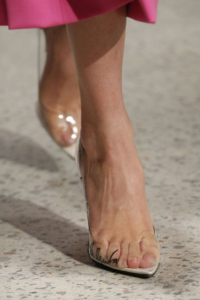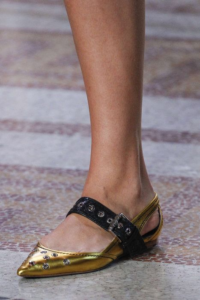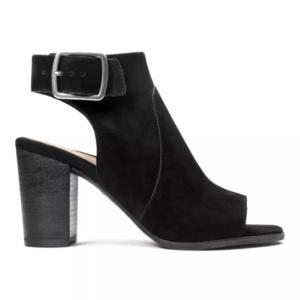
Welcome back to shop talk! This week we discuss one of the most common forefoot complaints that men and women experience with dress shoes – numb toes – broken down by one of our resident foot experts Elouise.
As Podiatrists, both Ele and myself are regularly treating this problem in the clinic. There are a few things which can cause numbness in the toes, however in this post we will be discussing by far the most common – a condition called Neuroma. Also called, ‘Morton’s neuroma’, the term neuroma simply refers to thickening and injury of certain nerves in the front of the foot. The majority of the time, neuroma can be linked to poorly fitted footwear, foot shape, and gait (walking) style. If you get numb toes in certain shoes, or even generally, it’s definitely worth reading on to learn more about this condition and how to fix it!

Firstly, a bit more about neuromas. What actually are they? Putting it simply, a neuroma is a thickening or fibrosis of the nerve that runs between the metatarsals (as in the picture above). Neuromas can occur in various locations between the metatarsals however it is most commonly found between the head of the 3rd and 4th metatarsal. The presence of a neuroma causes neurological symptoms in the foot such as burning, tingling and numbness and often the feeling of a pebble or lump under their forefoot. Neuroma symptoms start out as annoying but may progress to more severe pain and more importantly stop you from wearing your favourite heels!

As cute as these Bottega Veneta 2018 flats are, they would be torturous for a foot with a neuroma. The pointed toe, stitching at the widest point of the foot, low heel pitch and stiff unforgiving leather would trigger symptoms rapidly!
What causes a neuroma? There are multiple causes of neuromas but I’m afraid that poorly fitted dress shoes are the main reason. Prolonged use of pointed, tight or generally poorly fitting footwear may cause ongoing compression of the forefoot and over time pathological changes occur to the tissues within the foot. The nerves that run between the metatarsals build up fibrous/scar tissue at the point of highest pressure. This new thickened nerve requires less compression to produce painful or annoying neurological symptoms. Other causes of neuromas include-
- Forefoot deformities such as bunions of the 1st and/or 5th toe
- Long 3rd, 4th or 5th metatarsals
- Wide feet
- Feet that pronate excessively
- Unstable feet
- Activities and sports that load the forefoot excessively
What is the treatment for Neuromas? If you suspect you have a neuroma then you should consult your local podiatrist who will accurately diagnose and give you the best treatment for your foot type. Early treatments include footwear modification. Don’t panic! We are not suggesting that your stylish shoe days are over – far from it! You do however need to learn what dress shoes are right for your foot type. Try using The Shoe Equation! We have a specific section dedicated to those of you with a neuroma and we promise that these shoes are on trend and certainly not ugly.
Other treatments include-
- Interdigital spacers – these help to effectively reduce the pressure between the metatarsals
- Arch supports or orthotics – if you have an excessively pronated foot type then you should control it to reduce the risk of ongoing foot damage
- Ice, rest and activity modification – to help reduce inflammation and painful symptoms
- Corticosteroid injections – sometimes the use of anti-inflammatories is necessary to reduce the inflammation around the nerve
- Nerve ablation – usually performed under ultrasound, nerve ablation involves destroying the thickened portion of the nerve using radiofrequency or sometimes by injecting fluids
- Surgery – if all else fails then cut it out! Be aware that you will be left with a dulled sensation in your toes permanently which can be off putting.

Take a look at the Vionic Blakely Bootie. The internal arch support, forgiving upper across the forefoot and cushioning under the forefoot can help reduce the risk of neuroma symptoms. Shop the shoe on The Shoe Equation.
So, if you suspect you have the makings of a neuroma get yourself off for an assessment with a podiatrist. Early intervention is the key with this one. Don’t forget to take a look at The Shoe Equation which is carefully curated by us at TWH for all your footwear needs!
We hope you have found this useful information and please drop us a line if you would like us to write about any current shoes or foot conditions that you would like to know more about.
Until next time!
E&E
Image credits – Pinterest. Please contact hello@the-well-heeled.com to have your image further credited or removed



Charlene
Hi. I suspect this is my issue. Bad shoes for years and overpronation. So with a recent diagnosis of early arthritis in the hip and lower back I decided to get HOKA sneakers at my doctor’s recommendation. I received them today and, just as with my Brooks, my little toe and the one next to it goes numb when I walk on the left foot. I bought a half size up and there is a lot of room in toe bed. Should I ignore it? Thanks!
E&E
Hi Charlene,
Thank you for your comment.
We would recommend seeing a local podiatrist as there are other issues which can cause toe numbness besides tight shoes. The shoes you have bought are certainly wider styles and unlikely to be the problem.
Best wishes,
Ele
Paul Estabrook
hi I’ve had the same problem. bought hoka Clifton 9 shoes. and pinky toe on left foot goes numb . did you ever get your problem resloved
Gloria
I wear ASICS FF2 tennis shoes .
Everyday shoes I wear US 7.5
In tennis shoes I wear US 8.5
After playing 60-90 minutes both my feet go numb
When I stop it goes away .
I have NO numbness at any other time
What do you think it is ?
Crystal
I have the exact same issue with my Hoka’s. L foot and 4th and pinky toe! Same with On clouds but not with my other shoes.
reyhan
thanks a lot of information keren bgt